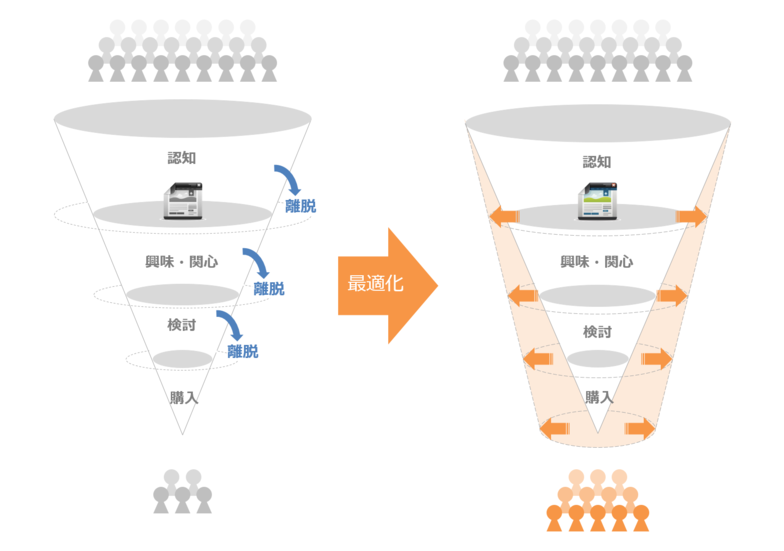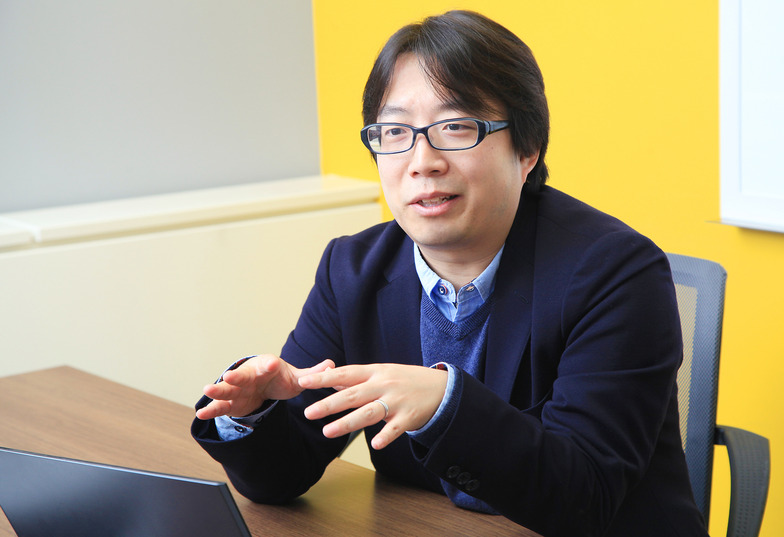"Website traffic increased, but conversions didn't follow." Many of you have likely experienced this frustrating situation. While Conversion Rate Optimization (CRO) has traditionally focused on improving landing pages and input forms, the future seems poised to emphasize scenario design that encompasses the entire marketing landscape and more granular, individualized optimization strategies. We spoke with Junichi Wada of Nextedge Dentsu Inc. and Satoru Yamamoto, CEO of Data Artist, about the future of CRO.
*Nexedge Dentsu Inc. became "Dentsu Digital Inc." effective July 1, 2016.

(From left) Junichi Wada of Nexedge Dentsu Inc., Satoru Yamamoto, CEO of Data Artist
Landing pages aren't the only thing for conversion optimization!?
──First, please tell us about your respective roles.
Wada: Within CRO, my main role is analyzing websites using Google Analytics (GA) and Adobe Analytics to identify site issues and improve conversion rates.
Yamamoto: I leverage technologies like machine learning and artificial intelligence to derive user insights from large datasets, support creative planning, and develop tools to streamline such analysis. In client work with Nextedge, I also develop customized analysis methods and tools tailored to specific needs.
──This time our theme is CRO. Could you explain the definition of conversion?
Yamamoto: While conversion often conjures images of direct purchasing actions like impulse buys on landing pages, its fundamental definition is "attitude conversion"—meaning any shift in user attitude. This encompasses all increases in user interest or engagement. For long-cycle products like real estate, detailed conversion points like form submissions or brochure requests are often established.
Wada: Since the ultimate goal of CRO is driving sales, while that remains the final metric, there's significant value in quantifying the journey leading up to it. Recently, content marketing has gained prominence from the perspective of "first capturing interest and engagement before focusing on how to get them to buy." Here, conversion is measured by how much content is read, meaning how much brand engagement has increased. A broader perspective on CRO that includes enhancing brand engagement is an area we should strengthen going forward.

Is implementing an A/B testing tool alone insufficient? The importance of consultants
──How is CRO actually implemented?
Yamamoto: While CRO covers a broad scope, I'll explain A/B testing, which many are familiar with. It involves measuring two creatives (A and B) and adopting the one with better conversion rates. Its popularity surged after President Obama used it in his election campaigns. However, the actual implementation methods don't seem widely understood. We often hear about cases where teams introduce A/B testing tools at the operational level but struggle to fully utilize them.
In theory, if time and effort were unlimited, repeatedly running A/B tests could lead to gradual improvements. But in reality, we need to achieve results within limited time and resources. Therefore, before implementing tools, having a consultant who can clearly define "what actions will yield how much improvement" is crucial. This consultant must not only have marketing experience but also the ability to propose data-driven improvements based on user behavior research.
Research methods vary widely, from extracting insights from big data to conducting large-scale group interviews. However, even simple online user research has proven effective. Online user research involves gathering a few general users as participants, having them actually use the website, and asking them to voice every thought they have during the process.

Flow from gaining insights through online user research to creative testing
──What kind of creative did you develop based on that research?
Yamamoto: Previously, when improving the website for an eye clinic offering LASIK, we conducted an online user survey. When participants viewed multiple LASIK websites, they commented on pages displaying photos of multiple ophthalmologists, saying things like, "Seeing so many doctors makes me feel reassured!" Conversely, for sites emphasizing low prices, they remarked, "It's so cheap it makes me uneasy."
The golden rule for CRO is "start where conversions are closest!" Even just the form can yield this much improvement!
──Where should we focus our investigations to see the best results?
Wada: Areas most likely to yield improvements are the first view, buttons, and input forms. Investigating these often reveals numerous issues. A common problem is input forms that demand users enter excessive information. Such forms often impose a heavy burden on users without actually utilizing the collected data. Therefore, input forms should minimize required fields, gathering necessary information at subsequent contact points instead.
──What input fields can be omitted?
Wada: Information close to personal details should be omitted because users hesitate to input it. First, address. If you just want to see application status by area, the prefecture alone is sufficient. Next, phone number. If you don't actually use the phone as a contact method, an email address alone is enough for the form.
Yamamoto: I've seen pages that included a warning like "Please enter information accurately" before the input form to prevent errors. That actually raised the barrier to entry. When we removed it, conversion rates improved.
Also, if users don't know when the input will end, they might quit midway. Displaying progress steps showing how much they've completed is a good idea.
Wada: For smartphones, ease of form input is also crucial. Making input fields larger improves conversion rates.
With CRO, starting near the conversion point tends to yield results more easily. The farther you are from the conversion, the more drop-off points increase, so it's best to start improving from the closest points.
Maximizing ROI by implementing CRO before launching ads
──In digital marketing, it's often said that "thoroughly optimizing CRO yields higher ROI than pouring money into ads." What does this mean?
Yamamoto: Imagine a physical store. If someone comes in after seeing your ad and finds the store dirty or the service poor, they won't buy anything. It's the same online: no matter how much you advertise, if your site is bad, conversions won't happen.
Doubling your ad spend might double conversions, but implementing CRO measures before doubling your budget allows you to achieve conversions more efficiently with the same ad spend.
Moreover, sites with high conversion rates also see higher repeat customer rates. Conversions happen because the product's appeal is effectively communicated. This impact extends beyond the moment of purchase to subsequent customer interactions, contributing to LTV (Life Time Value).
Wada: When CRO increases the conversion rate from 1% to 1.2%, converting that back to advertising terms really highlights the cost-effectiveness of CRO. So, if you implement CRO before investing in advertising, you can sometimes achieve several times the effect for the same cost.
──In the case of Nextedge Dentsu Inc., do you typically receive requests from clients for ad management and then propose CRO as well?
Wada: That's correct. If we see that ads are driving traffic but not converting on the landing page, we propose CRO as part of the advertising package.
Recently, client expectations have risen. We're increasingly asked not just for landing page A/B testing, but to deliver results across the entire marketing funnel.
──I see. In the latter half, we'll delve deeper into CRO with a focus on brand engagement and optimizing the entire customer journey.
< Continued in Part 2 >














